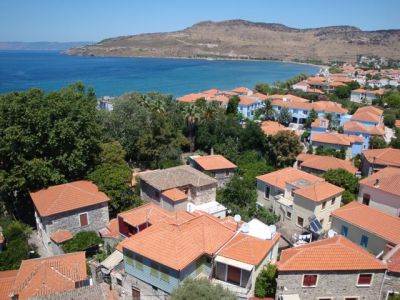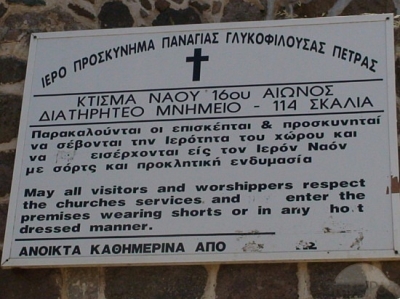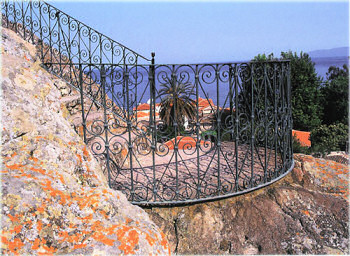
 From the evening of the 14th through the day and night of the 15th of August, thousands of pilgrims ascended the Holy Rock of Petra to honor the Panagia—She Who Is All Holy.
From the evening of the 14th through the day and night of the 15th of August, thousands of pilgrims ascended the Holy Rock of Petra to honor the Panagia—She Who Is All Holy.
There is “something really beautiful”* in being among them.
Six of us set out from Molivos at 7:30 on the 14th to meet in the square of Petra to ascend to the church. Petra was already full of so many pilgrims that police had forbidden traffic in the main square and were directing cars into a nearly full parking lot in a field. When we got out of the car, the two others who came with me and I had a perfect view of the steady stream of pilgrims climbing the rock, which was already lit up in the twilight.
When we found the others, I said that we would climb to the church on the top of the rock where we would light candles and approach the icon of the Panagia to silently pray or express a wish for the coming year. The others followed me through the square into the winding streets lined with stalls and gypsy beggars to the bottom of the rock. While we waited for our turn, we saw the sign advising pilgrims of proper dress (read carefully).
We took our place in the line and began the ascent up 114 steps carved into the rock, some with added hand cut stones held in place with brass clasps. The steps are high and we had to take care of our footing. A service in the church broadcast by loudspeakers sounded very much like Jewish chanting. I explained that the early Christians were Jews—even in Greece where Jews made up 10% of the population of the cities of the Roman Empire. As in Judaism, for Orthodox Christianity the day begins as sunset.
As we reached the top of the rock, I realized that a mother and her blind adult son were just in front of me. Some people were queuing to enter through the former monastery’s fortress-like gates, while others sat on stone benches at the entry way entranced by views of the surrounding village, its fields, and the sea in the last light of the day.
As we entered the gates we temporarily lost each other in the crowd, and then found ourselves directed by a beautiful female police officer to the main entrance of the church at the far end of the enclosure. We entered the church just in time to witness a procession of priests in brocaded robes. The celebration was so obviously “not about them” that I appreciated the colors of their robes and their movement, not even thinking about the male hierarchy of the church.
The receptacle for the candles was swimming in melted beeswax. I led our small group to the left aisle of the church where a bucket of holy water sat on the wooden lid of a well, spring water rising up through the rock. My friends sensed that the spring is one of the reasons “this place is holy.” Indeed as I later told them, the spring is a result of volcanic activity in the area some 20 million years ago, and the spring water originates on Sacred Mount Ida, across the sea channel in Turkey. Before continuing, we anointed ourselves with the sacred water.
![]() From there, we found our way to the holy icon of the Panagia on the left side of the iconostasis. The image of Mother and Child has a silver casing embossed with roses. For the festival it was decorated with scores of red roses. The red of the roses and the silver gleam of the icon were eye-catching in the dimly lit church. “She” was the place and the reason we had come. After a short wait, we entered a line and approached. There wasn’t time for a long litany of prayers, so I simply formed the words health and healing in my mind while touching my hands and forehead to the icon.
From there, we found our way to the holy icon of the Panagia on the left side of the iconostasis. The image of Mother and Child has a silver casing embossed with roses. For the festival it was decorated with scores of red roses. The red of the roses and the silver gleam of the icon were eye-catching in the dimly lit church. “She” was the place and the reason we had come. After a short wait, we entered a line and approached. There wasn’t time for a long litany of prayers, so I simply formed the words health and healing in my mind while touching my hands and forehead to the icon.
As we left by the side door guarded by the female police officer, I turned back to ask her “Was this the service marking the moment of the Panagia’s “falling asleep”? She nodded.
 We paused in the open area in front of the church for a few minutes to take in the views, and then found our way down the 114 steps. By this time more pilgrims had arrived and the streets were even more crowded. We walked along the main road by the sea to the other end of the village where taverna owners have placed platforms in the sand. The taverna I had chosen was full, but the adjoining one had room for us at two tables pulled together under a tamarisk tree. By this time it was too dark to see the sea, but we could hear its gentle lapping all through dinner.
We paused in the open area in front of the church for a few minutes to take in the views, and then found our way down the 114 steps. By this time more pilgrims had arrived and the streets were even more crowded. We walked along the main road by the sea to the other end of the village where taverna owners have placed platforms in the sand. The taverna I had chosen was full, but the adjoining one had room for us at two tables pulled together under a tamarisk tree. By this time it was too dark to see the sea, but we could hear its gentle lapping all through dinner.
Our little party was made up of an English woman who had recently moved to Molivos (where I live), an English-Irish couple, and an English mother and daughter, all of whom have fallen in love with the island, and me. While we waited to order, I explained that the rock on which the church is perched is a vein of volcanic lava that was pushing its way up through a mountain but never exploded through. Over millions of years, the mountain wore away, leaving the denser volcanic magma. Archaeologists believe that a temple to Artemis was succeeded by the current one to the Panagia.
Our conversation flowed easily. The intimacy we shared testified to the fact that we had each been deeply moved. Early in the evening the mother stated that her 16 year old daughter had been having a “hard year.” Later, the conversation turned to the differences between school children today and the school children we adults once were. Something prompted me to ask the daughter who was sitting across from me, “Have you been bullied.” “Yes.”
The mother immediately took over the conversation, filling in the details from her perspective in an effort to shield her daughter. Sensing the daughter’s discomfort, I reached out my hand and said, “This should not have happened to you.” I have learned that acknowledgement of their pain and suffering is what abused children need most. The daughter’s eyes welled with tears as she managed “Thank you.” When the party broke up I gave the daughter an extra long hug, after which the mother said, “I think I will send her to you.”
Healing had occurred, by the grace of the Panagia whose festival brought us together.
As we walked back to the car, the couple asked me about the unusual crowds of people still thronging the streets as the hour neared midnight. There were foreign tourists and Greek tourists, but there were also older couples and families who had obviously come down from the surrounding villages. I had been asking my Greek friends what they understood about 15 August. Only one mentioned the assumption and all stated that they did not believe in life after death. I didn’t know what the other members of our group believed about what we had just experienced. Then I realized that what we believed or did not believe was irrelevant: we had all come together to honor the Mother.
*See Xochitl Alvizo’s response to my earlier post Hidden Meanings in the Rituals of the Assumption.
Carol P. Christ is still dreaming of the spring Goddess Pilgrimage to Crete which she led through Ariadne Institute. The culture of ancient Crete, the last flowering of Old Europe, is one of the wellsprings of her spiritual vision, and there she participates in rituals that invoke Goddess and celebrate the connection of all beings in the web of life. It is not too late to join the fall pilgrimage, nor too early to sign up for spring 2014. Carol can be heard on a WATER Teleconference. Her books include She Who Changes and Rebirth of the Goddess and the widely-used anthologies Womanspirit Rising and Weaving the Visions.




Brought tears to my eyes x
LikeLike
Thanks, Carol, for sharing your celebration of the Panagia. I almost feel like I was there with your group. The white out on the sign you mention is delightful. And there are many expressions in your post that imitate our lives as journeys, so wondrously!!
“The steps are high and we had to take care of our footing…”
“As we entered the gates we temporarily lost each other in the crowd…”
“By this time it was too dark to see the sea, but we could hear its gentle lapping all through dinner…”
“The intimacy we shared testified to the fact that we had each been deeply moved…”
LikeLike
I was wondering if anyone would see the white out on the sign. It is significant that this sign has been this way for years and no one has taken it upon him or herself to correct it. Deference to the clergy is not widespread in Lesbos. Moreover, though women are not to come into church with uncovered arms or in slacks in Greek tradition, these customs are continually breached. Strapless bride dresses are popular and short skirts everywhere among the assembled friends and family at weddings and baptisms.
LikeLike
Dear Karolina, I vividly remember climbing the rock in Petra, and spending time in the church. I also remember climbing down in the dusk and seeing owls nesting in the rock. We ate in a taverna overlooking the sea, and saw the most beautiful sunset of our lives. Every now and then a dog wandered into the taverna, and was petted before moving on. Later on, when we left the taverna, people were playing music, just local people, not a band, and everyone was dancing in the street. There were some tourists, but mostly the dancers were local people. I thought that these people really had joyful lives. I hated leaving that town, knowing that I would probably never return.
LikeLike
This is lovely. Is Petra the monastery where formerly nothing female was ever allowed to enter? I seem to remember reading about it. If so, how was the space reclaimed for the Goddess?
LikeLike
not the same one, but I am sure the Panagia is revered on Mt. Athos…
what I described falls more into the category of folk religious practices.
LikeLike
Lovely..and may the Mother ever be honored in just this sort of unification: across age, gender and belief! Thanks
LikeLike
Carol, thank you so much for taking us with you!
LikeLike
Smiling.
LikeLike
Great story. She looks like a Black Madonna.
Thanks
LikeLike
Yes most Greek Panagias are dark-eyed and dark-haired and have darkish or dark skin with “European” features. In this case, the icon is old and also somewhat darkened with age.
LikeLike
Carol:
Thank you, as always, for your lovely descriptions and thoughts. So just for you, a very impoverished, but from the heart, response, written just after I had read your piece.
Panaghia: In honor of the Most Holy and her daughter, Carol.
Tears well up
From dark depths.
The stairs are steep, the rock is hard.
At the top, light glitters, flickers.
We see Her only in reflections
From Her own self-knowing.
LikeLike
thanks
LikeLike